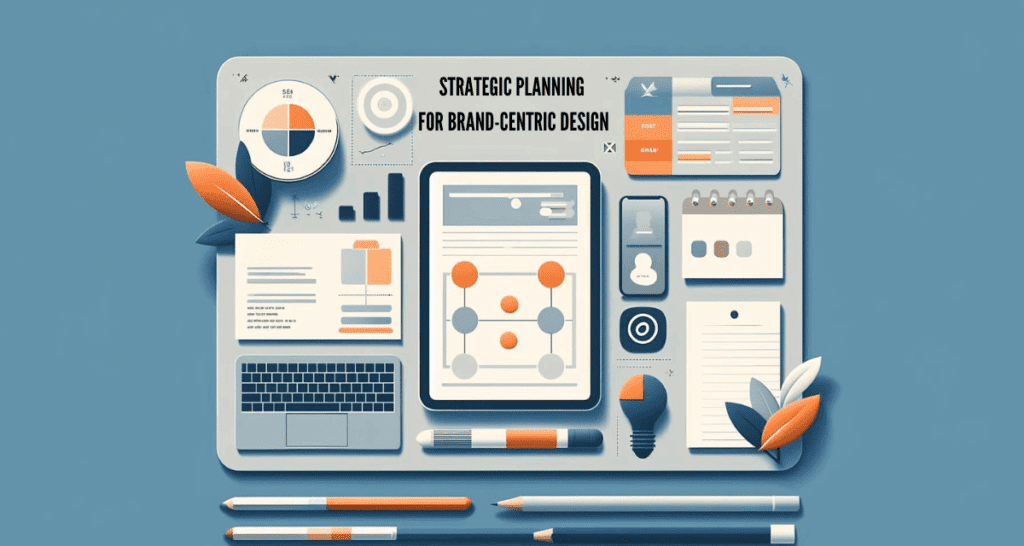Understanding the Impact of Web Design on Brand Identity
In today’s digital era, the importance of a strong brand identity cannot be overstated. At the heart of digital marketing, the role of web design in shaping how your brand is perceived is vital. Whether you’re just starting out or looking to upgrade your online presence, understanding the complex relationship between your brand’s identity and your website’s design is the first step towards crafting a memorable brand experience.
Web design is more than just creating a visually appealing site. It’s about communicating your brand’s values and message in a clear and engaging manner. This section will guide you through the basics of how web design can enhance your brand identity, setting the stage for a deeper dive into strategic planning and execution.
Fundamentals of Brand Identity in Web Design


Understanding Brand Identity Elements
Brand identity is what sets your company apart from the competition. It’s a combination of how your brand looks, feels, and speaks to consumers. Key components like your logo, color scheme, typography, and imagery all play critical roles in making your brand recognizable and relatable.
How to Visualize Brand Identity Through Web Design
When it comes to web design, each element needs to reflect your brand’s identity. For instance, your logo should be prominently placed where visitors expect to find it, like the top left corner of every page. This maintains brand consistency and aids in quick recognition.
Color schemes should mirror the emotions and values your brand stands for. For example, blue often conveys trust and dependability and is favored by financial institutions. Choosing the right fonts and images also reinforces the personality of your brand, making your website not just a portal of information but a true reflection of your brand’s character.
The Role of Web Design in Branding
A consistent web design across all pages not only helps in reinforcing your brand’s image but also ensures a integrated user experience. This consistency tells your customers they are in the right place and builds trust.
Creating a Uniform Brand Experience Online
Your website is often the first point of contact for potential customers, making it critical in establishing a strong first impression. Consistent header designs, button styles, and even the tone of your content can make your brand more memorable. This uniformity helps in building a professional image that customers come to trust and rely on.
Strategic Planning for Brand-Centric Web Design


Aligning Design with Brand Values and Audience
Understanding your brand values and audience is crucial when designing your website. Your web design should not only reflect who you are as a brand but also serve to the expectations of your audience.
Tailoring Web Design to Reflect Core Brand Values
To successfully align your web design with your brand values, start by listing what your brand stands for. Is your brand about innovation, reliability, or perhaps eco-friendliness? Each of these traits should be communicated visually through your web design.
Case Studies: Effective Brand and Design Alignment
Consider a brand like Apple, known for its clean, minimalist design both in product and web presence. Their website uses spacious layouts and a monochromatic color palette, reinforcing their branding as sleek and modern.
Setting Measurable Web Design Objectives
Setting clear, actionable goals for your web design project is necessary. These objectives might range from increasing brand recognition to enhancing user engagement.
Examples of Web Design Goals
Increase Brand Recognition: Use a unique color scheme and logo placement that stands out.
Improve User Engagement: Integrate interactive elements like hover effects or animation that invite interaction without overwhelming the user.
Integrating Web Design with Overall Branding Strategy


Streamlining Brand Messaging Through Design
Effective brand messaging involves more than just the content; it’s about how that content is presented. To achieve this:
Consistency: Ensure that logos, colors, and typography are consistent across all digital platforms. This uniformity helps in reinforcing the brand identity and increases recognition.
Content Placement: Strategically place key messages in high-visibility areas such as the homepage banner or the top of landing pages to catch the user’s attention immediately.
Enhancing Engagement Through Interactive Elements
Interactive elements not only attract attention but also increase the time users spend interacting with your site, which can lead to higher engagement rates:
Animations: Implement subtle animations that activate during scroll or hover to draw attention to special offers or calls to action without being intrusive.
Hover Effects: Design hover effects for menu items and buttons to give immediate feedback to users, making the site feel responsive and alive.
Ensuring a Consistent User Experience
A consistent user experience across all pages of the website reassures visitors of your brand’s reliability and professionalism:
Simple Navigation: Maintain a simple and predictable navigation structure that helps users find information quickly and easily.
Design Uniformity: Use a coherent style template that includes layout consistency, matching color schemes, and uniform typography to strengthen the brand’s visual narrative.
Showcasing Brand Innovation with Technology
Leveraging the latest web technologies can position your brand as a leader in innovation:
Augmented Reality (AR): Utilize AR features to allow users to see how products might look in real life, enhancing the decision-making process.
AI-Driven Chatbots: Implement smart chatbots that provide personalized assistance, making interactions more engaging and efficient.
Promoting Sustainability and Accessibility
Incorporating sustainable practices and ensuring accessibility shows commitment to social responsibility:
Eco-Friendly Practices: Choose green web hosting and optimize site code to minimize energy consumption.
Accessibility: Ensure that the website is accessible by following ADA guidelines, providing text alternatives for images, and ensuring good color contrast.
SEO and Usability Optimization


Integrating SEO Best Practices with Web Design
Search engine optimization (SEO) is crucial for enhancing your website’s visibility and supporting your brand identity. Here are ways to integrate SEO effectively into your web design:
Keyword Integration: Seamlessly incorporate relevant keywords into your content, titles, and meta descriptions to improve rankings without compromising readability.
Mobile Optimization: Ensure your website is responsive on all devices, as mobile-friendliness is a significant ranking factor for search engines.
you need to read some resources for further understanding this :
How Web Design Influences SEO in 2024.
The Ultimate Mobile SEO Checklist.
Enhancing Usability for Better Brand Engagement
A user-friendly website can significantly boost user engagement and overall satisfaction, which in turn enhances brand perception:
Loading Speed: Optimize images and streamline code to increase page loading speed, improving user experience and SEO.
Navigational Clarity: Design a clear, intuitive navigation structure that allows users to find information quickly and easily, reducing bounce rates and increasing time on site.
Building Credibility with Quality Content
Content is king in both SEO and user engagement. Quality content not only ranks better but also establishes your brand as an authority in your niche:
Informative Content: Provide valuable, informative content that answers user questions and provides real solutions.
Regular Updates: Keep content fresh and updated to engage users and encourage them to return, which signals to search engines that your site is relevant.
Implementing Technical SEO for a Stronger Online Presence
Technical SEO refers to the non-content elements of your website that can be optimized to improve search rankings:
Site Architecture: Ensure your site architecture is SEO-friendly by using a logical structure that search engines can follow easily.
Secure Website: Implement HTTPS to secure your site and boost SEO, as security is a top priority for search engines.
Building Trust Through Professional Web Design.
Conclusion: Recap and Forward-Looking Statements
Recap of Key Points Covered
Throughout this guide, we’ve explored various ways of how effective web design can enhance brand identity. From understanding the foundational elements of branding in web design, through strategic planning and the integration of cutting-edge trends and technologies, we’ve outlined actionable steps businesses can take to elevate their brand presence online.
Encouragement to Continually Evolve and Adapt Web Design Strategies
The digital world is dynamic, with new trends and technologies emerging continually. For businesses, this means there is always an opportunity to innovate and improve. By staying updated with the latest design trends, listening to user feedback, and testing new ideas, you can ensure that your website remains a powerful tool in building and maintaining a strong brand identity.
- Leveraging Analytics for Web Design Optimization - April 30, 2024
- The Role of Artificial Intelligence in Web Design - April 29, 2024
- How to Create an Inclusive Web Design - April 26, 2024

